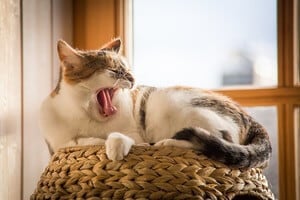If you’re a cat owner, you know all too well the bother of your cat’s hairballs. Not only is the coughing and gagging a frequent cause of worry for you, but it also has to be annoying for your poor cat, too. It will often lead to vomit, also, which makes it more than just annoying for you both: it’s flat out disgusting. In extreme cases, it can even hurt your poor kitty’s throat and cause an upset stomach, or blockages that can be a real health concern if left untreated.
Because hairballs are such a common nuisance, we’ve taken the liberty of listing some preventative measures below that you can take to minimize their impact on your life and their trouble for your cat.
1. Brush Your Cat Regularly
The best preventative measure for hairballs is to get rid of the hair yourself. That means getting a good kitty brush and brushing your cat often so that when she decides she needs to clean herself, she isn’t also choking down all her shedding hair. Make it a relaxing experience for her by doing it as she lounges on your lap so that she won’t fight you; because the less she fights, the easier it is. And the easier it is, the more likely you are to do it!
2. Try Treatments and Oils
There are several gels and oils that you can buy to aid with hairball digestion, such as Dechra Cat Lax Cat Hairball Remedies, but you can try other home remedies as well. Stirring in a bit of olive oil with her food can help, and corn oil, saffron oil, and plain butter are known to help with hairballs as well.
You could also try applying some Vaseline on her paws a few times a week. It will bother her a bit (but don’t worry, it’s just a mild annoyance, not torture), and she’ll lick it off immediately. The Vaseline lubricates her digestive tract, helping your kitty pass those hairballs. You can also add a small amount of Metamucil into her food by mixing a half teaspoon of the powder with water and stirring it into her food daily – at least until you think you have those hairballs under control.
3. Make Dietary Modifications
You may want to run it by your vet before you change your cat’s diet too drastically, but if you’re interested in helping your cat without buying a lot of extra products, you can try giving her the oil from your next can of tuna to help lubricate her digestive tract. Along those lines, sardines can also help to ease the digestion of those pesky hairballs. Canned pumpkin puree would also help your cat increase her fiber intake and minimize the clogging hair.
You can also try a cat food that has hairball-prevention benefits. Or, you can work other high-fiber foods you know work for you into your cat’s diet. Do this with caution, however, because most people’s foods are not intended for cats. In small amounts, though, you may find a high fiber cereal like Grape Nuts particularly helpful on an occasional basis.
If you’re looking for a natural or organic cat food that’s right for your feline friend, check out out list of the Best Organic Cat Foods.
4. Take Control of Grooming
If you’re interested in her minimizing her hairballs, there are a few tricks you can use to mold your kitty’s grooming habits. For instance, you can massage a small dab of conditioner into your cat’s fur a few times per week. This can put a nix on the static electricity she picks up, too, if that’s been bothering you. Baby wipes can help the shedding; just use them after a good brushing to wipe off the hair that is waiting to be pulled off by her tongue. Make sure you get the fragrance-free wipes to prevent incurring your cat’s wrath should she not like the smell.
All the extra effort you put in may make her licking less frequent, but even if it doesn’t, you’ll still need to keep an eye on it. If she still licks for more than just a few seconds at a time, you may want to intervene. Whenever you can, discourage her excessive licking by distracting her. Engaging her in play will help pull her away from the licking habit, and a more active kitty is a healthier kitty.
5. Keep Her Hydrated
You may be surprised to find your cat is not actually getting as much water as she should. Your cat should be drinking about 4-8 ounces of water each day, in addition to her food. Dry food obviously has less water so she should be on the higher end of that range if she’s a dry food eater. You’ll also want to account for her activity which may change her requirements, too. Pushing water on your cat isn’t always easy since they’re known for not wanting to touch water too much. But making sure she drinks plenty of water will help her pass the hair quickly. And a healthy, hydrated coat will shed less.
You’ll want to make sure she has access to water at all times. That may mean putting water in several areas and in several different containers. Since cats are curious by nature, an unusual bowl or cup may peak her interest. You can also pick up a water fountain that may entertain her (but be careful of the mess she’s bound to make playing). You can also add a few ice cubes or even a bit of sodium-free, low-fat chicken or beef broth to lure her.
While eliminating hairballs entirely may not be an attainable goal, you can certainly minimize the risks involved and protect your cat from the pain of suffering them regularly. Follow the steps above, and your cat will surely thank you!






























